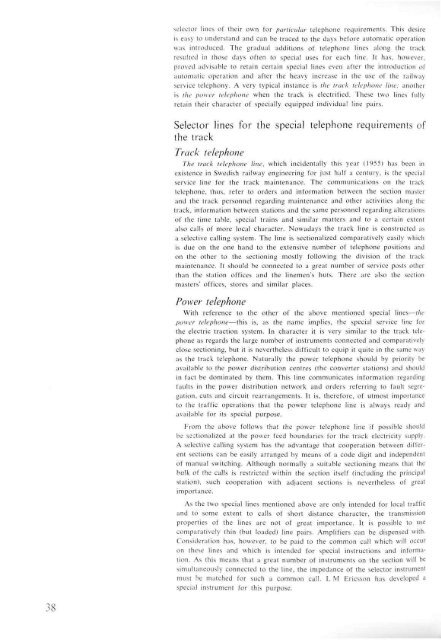II - History of Ericsson - History of Ericsson
II - History of Ericsson - History of Ericsson
II - History of Ericsson - History of Ericsson
Create successful ePaper yourself
Turn your PDF publications into a flip-book with our unique Google optimized e-Paper software.
selector lines <strong>of</strong> their own for particular telephone requirements. This desire<br />
is easy to understand and can be traced to the days before automatic operation<br />
was introduced. The gradual additions <strong>of</strong> telephone lines along the track<br />
resulted in those days <strong>of</strong>ten to special uses for each line. It has, however,<br />
proved advisable to retain certain special lines even after the introduction <strong>of</strong><br />
automatic operation and after the heavy increase in the use <strong>of</strong> the railway<br />
service telephony. A very typical instance is the track telephone line; another<br />
is the power telephone when the track is electrified. These two lines fully<br />
retain their character <strong>of</strong> specially equipped individual line pairs.<br />
Selector lines for the special telephone requirements <strong>of</strong><br />
the track<br />
Track telephone<br />
The track telephone line, which incidentally this year (1955) has been in<br />
existence in Swedish railway engineering for just half a century, is the special<br />
service line for the track maintenance. The communications on the track<br />
telephone, thus, refer to orders and information between the section master<br />
and the track personnel regarding maintenance and other activities along the<br />
track, information between stations and the same personnel regarding alterations<br />
<strong>of</strong> the time table, special trains and similar matters and to a certain extent<br />
also calls <strong>of</strong> more local character. Nowadays the track line is constructed as<br />
a selective calling system. The line is sectionalized comparatively easily which<br />
is due on the one hand to the extensive number <strong>of</strong> telephone positions and<br />
on the other to the sectioning mostly following the division <strong>of</strong> the track<br />
maintenance. It should be connected to a great number <strong>of</strong> service posts other<br />
than the station <strong>of</strong>fices and the linemen's huts. There are also the section<br />
masters' <strong>of</strong>fices, stores and similar places.<br />
Power telephone<br />
With reference to the other <strong>of</strong> the above mentioned special lines—the<br />
power telephone—this is, as the name implies, the special service line for<br />
the electric traction system. In character it is very similar to the track telephone<br />
as regards the large number <strong>of</strong> instruments connected and comparatively<br />
close sectioning, but it is nevertheless difficult to equip it quite in the same way<br />
as the track telephone. Naturally the power telephone should by priority be<br />
available to the power distribution centres (the converter stations) and should<br />
in fact be dominated by them. This line communicates information regarding<br />
faults in the power distribution network and orders referring to fault segregation,<br />
cuts and circuit rearrangements. It is, therefore, <strong>of</strong> utmost importance<br />
to the traffic operations that the power telephone line is always ready and<br />
available for its special purpose.<br />
From the above follows that the power telephone line if possible should<br />
be ssctionalized at the power feed boundaries for the track electricity supply.<br />
A selective calling system has the advantage that cooperation between different<br />
sections can be easily arranged by means <strong>of</strong> a code digit and independent<br />
<strong>of</strong> manual switching. Although normally a suitable sectioning means that the<br />
bulk <strong>of</strong> the calls is restricted within the section itself (including the principal<br />
station), such cooperation with adjacent sections is nevertheless <strong>of</strong> great<br />
importance.<br />
As the two special lines mentioned above are only intended for local traffic<br />
and to some extent to calls <strong>of</strong> short distance character, the transmission<br />
properties <strong>of</strong> the lines are not <strong>of</strong> great importance. It is possible to use<br />
comparatively thin (but loaded) line pairs. Amplifiers can be dispensed with.<br />
Consideration has, however, to be paid to the common call which will occur<br />
on these lines and which is intended for special instructions and information.<br />
As this means that a great number <strong>of</strong> instruments on the section will be<br />
simultaneously connected to the line, the impedance <strong>of</strong> the selector instrument<br />
must be matched for such a common call. L M <strong>Ericsson</strong> has developed a<br />
special instrument for this purpose.
















